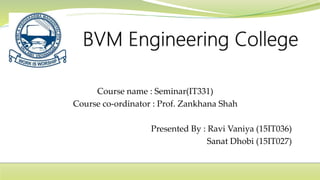Module 2 memory storagedevices
•Download as PPTX, PDF•
0 likes•43 views
It talks about data storage history
Report
Share
Report
Share

Recommended
Recommended
More Related Content
Similar to Module 2 memory storagedevices
Similar to Module 2 memory storagedevices (20)
"Toward Sustainability: "Margin" and "Mission" in the Natural History Setting...

"Toward Sustainability: "Margin" and "Mission" in the Natural History Setting...
Synthesis and Integration in the Natural History Commons

Synthesis and Integration in the Natural History Commons
International Perspectives: Visualization in Science and Education

International Perspectives: Visualization in Science and Education
At the Interface of Religion and Cosmopolitanism: Bernard Picart's "Cérémonie...

At the Interface of Religion and Cosmopolitanism: Bernard Picart's "Cérémonie...
nternational Biodiversity Projects and Natural History Museums: Current stat...

nternational Biodiversity Projects and Natural History Museums: Current stat...
Linked data for knowledge curation in humanities research

Linked data for knowledge curation in humanities research
Digital Scholarship Intersection Scale Social Machines

Digital Scholarship Intersection Scale Social Machines
Recently uploaded
Recently uploaded (20)
Factor Causing low production and physiology of mamary Gland

Factor Causing low production and physiology of mamary Gland
Nanoparticles for the Treatment of Alzheimer’s Disease_102718.pptx

Nanoparticles for the Treatment of Alzheimer’s Disease_102718.pptx
Vital Signs of Animals Presentation By Aftab Ahmed Rahimoon

Vital Signs of Animals Presentation By Aftab Ahmed Rahimoon
POST TRANSCRIPTIONAL GENE SILENCING-AN INTRODUCTION.pptx

POST TRANSCRIPTIONAL GENE SILENCING-AN INTRODUCTION.pptx
Costs to heap leach gold ore tailings in Karamoja region of Uganda

Costs to heap leach gold ore tailings in Karamoja region of Uganda
MSC IV_Forensic medicine - Mechanical injuries.pdf

MSC IV_Forensic medicine - Mechanical injuries.pdf
dkNET Webinar: The 4DN Data Portal - Data, Resources and Tools to Help Elucid...

dkNET Webinar: The 4DN Data Portal - Data, Resources and Tools to Help Elucid...
Efficient spin-up of Earth System Models usingsequence acceleration

Efficient spin-up of Earth System Models usingsequence acceleration
Film Coated Tablet and Film Coating raw materials.pdf

Film Coated Tablet and Film Coating raw materials.pdf
Heat Units in plant physiology and the importance of Growing Degree days

Heat Units in plant physiology and the importance of Growing Degree days
Module 2 memory storagedevices
- 1. Course name : Seminar(IT331) Course co-ordinator : Prof. Zankhana Shah Presented By : Ravi Vaniya (15IT036) Sanat Dhobi (15IT027)
- 2. From Magnetic drive to Genomic drive
- 3. History (Evolution of Memory Storage Devices)
- 4. Let’s Recap… Deoxyribonucleic acid (DNA) is a molecule that carries the genetic (hereditary) instructions used in the growth, development all living organism. It consist of two biopolymer strands coiled around each other to form a double helix. Made up of four nitrogen bases: adenine (A), guanine (G), cytosine (C), and thymine (T). Nucleotide = Nitrogen base + Sugar + Phosphate.
- 5. Earlier devices In mid-1700 – Punch card It was used for input both of programs and data. Used as early as 1725 in the textile industry (for controlling mechanized textile looms). In 1946 – Selectron tube Capacity - 32 to 512 bytes. 4096-bit Selectron was 10 inches long and 3 inches wide. Con’s - expensive and production problems.
- 7. Earlier devices … In 1932 – Magnetic drum memory Memory capacity - 10 kB. In 1951 – Magnetic tape In 1956 – Hard disk drive IBM Model 350 - It had 50 24-inch discs with a total storage capacity of 5 million characters (just under 5 MB). In 1971 – First Floppy drive (Diskette). In 1978 – Compact disc In 1980 – Hard disk drive (First 1 GB drive)
- 9. After 1990s … DVD and Flask storage (like SD card). Micro drive Holography. Cloud storage.
- 10. Timeline
- 11. History The idea about the possibility of recording, storage and retrieval of information on DNA molecules were originally made by Mikhail Neiman He published his idea in 1964–65 in the Radiotekhnika journal, USSR(now Russia), and the technology during that time was referred to as MNeimONics(Mikhail Neiman OligoNucleotides).
- 12. History … In 2007 a device was created at the University of Arizona, but during that time DNA synthesis was expensive as well as laborious process. On August 16, 2012, the journal Science published research by George Church and his colleagues at Harvard University, in which DNA was encoded with digital information that included an HTML pages of a 53,400 words, 11 JPG images and 1 JavaScript program. Many other projects were taken in January 2013 - European Bioinformatics Institute April 2016 - University of Washington March 2017 - Columbia University and New York Genome Center
- 13. Past , Present and Future…
- 14. References ... Official website : University of Washington Official website : Microsoft Inc. https://en.wikipedia.org/wiki/DNA https://en.wikipedia.org/wiki/DNA_digital_data_storage http://www.zetta.net/about/blog/history-data-storage-technology For images : Wikipedia and Zetta Labs images.